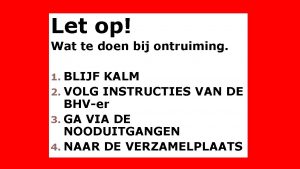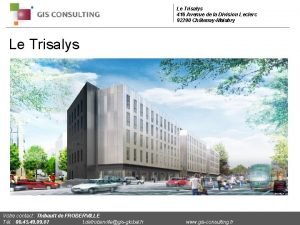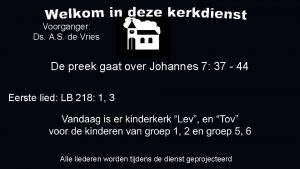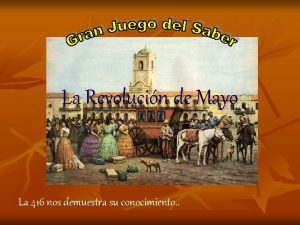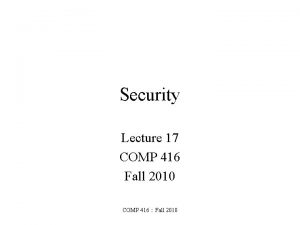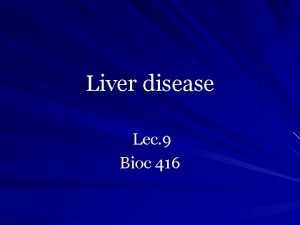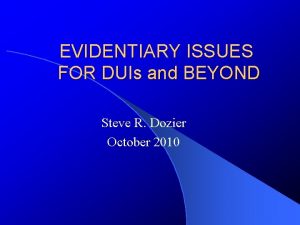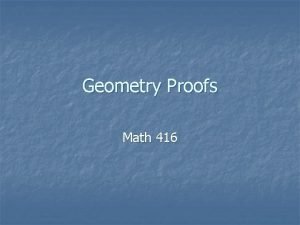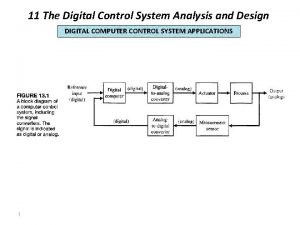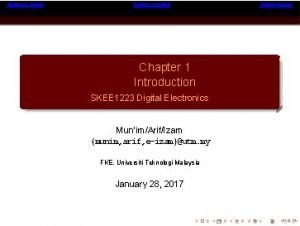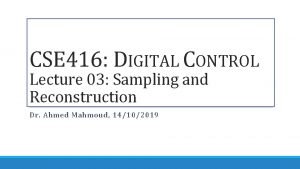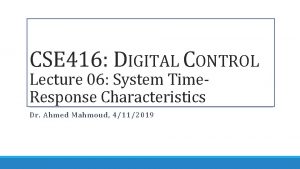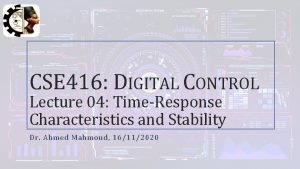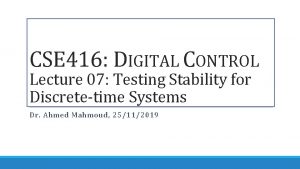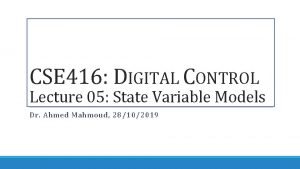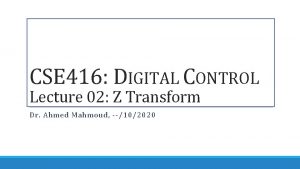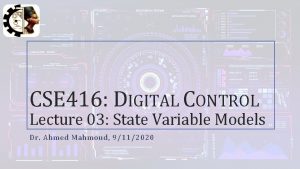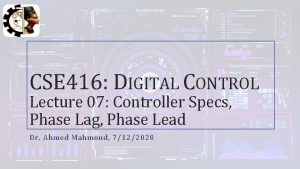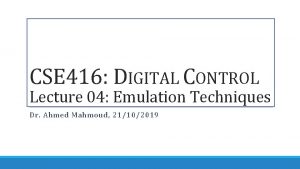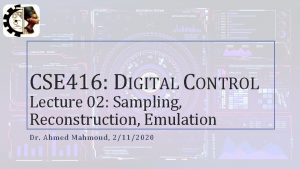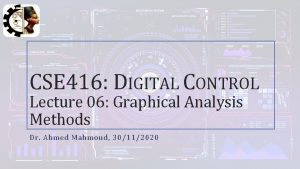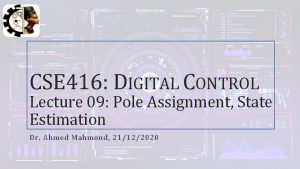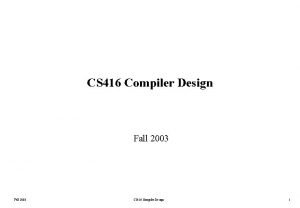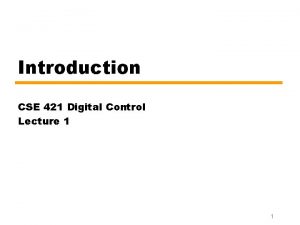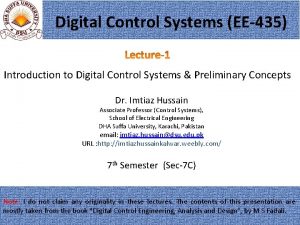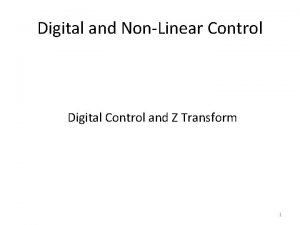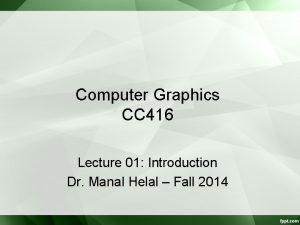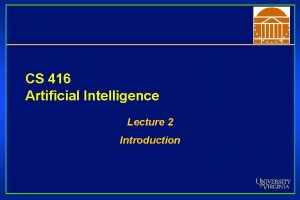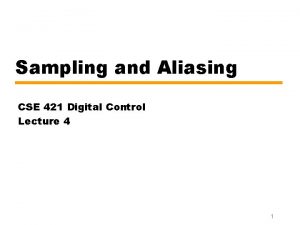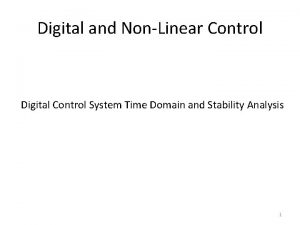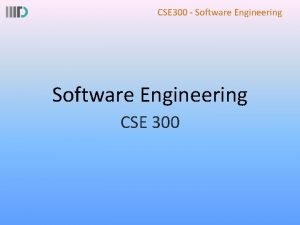CSE 416 DIGITAL CONTROL Lecture 01 Introduction and






















- Slides: 22

CSE 416: DIGITAL CONTROL Lecture 01: Introduction and Review Dr. Ahmed Mahmoud, --/10/2020

Course Logistics • Course by: Dr. Ahmed Mahmoud, and Eng. Muhammed Essam. • Lecture is on Monday 10: 00 AM to 02: 00 PM. • Tutorial session is on (To be determined with Eng. Muhammed Essam). • Grading: • Total = 150. • Final = 100. • Semester work = 50 (30 midterm exam + 20 sheets, labs, and attendance). • Course is hosted on Piazza. --/10/2020 CSE 416: DIGITAL CONTROL 2

Course Textbooks • Phillips, Charles L. , and H. Troy Nagle. Digital control system analysis and design. Prentice Hall Press, 2007. • Franklin, Gene F. , J. David Powell, and Michael L. Workman. Digital control of dynamic systems. Menlo Park, CA: Addison-Wesley, 1998. --/10/2020 CSE 416: DIGITAL CONTROL 3

The Control Block Diagram • The plant has dynamics; • We will program the computer such that it has dynamics of the same nature as those of the plant. • Although generally we cannot choose the dynamics of the plant, we can choose those of the computer such that, in some sense, the dynamics of the closed-loop system are satisfactory. --/10/2020 CSE 416: DIGITAL CONTROL 4

The Control Problem • A physical system or process is to be accurately controlled through closedloop, or feedback, operation. An output variable (signal), called the response, is adjusted as required by an error signal. The error signal is a measure of the difference between the system response, as determined by a sensor, and the desired response. • Generally, a controller, or filter, is required to process the error signal in order that certain control criteria, or specifications, will be satisfied. • Criteria may involve, but not be limited to: 1. Disturbance rejection 2. Steady-state errors 3. Transient response 4. Sensitivity to parameter changes in the plant --/10/2020 CSE 416: DIGITAL CONTROL 5

Solving the Control Problem 1. Choosing sensors to measure the required feedback signals. 2. Choosing actuators to drive the plant. 3. Developing the plant, sensor, and actuator models (equations). 4. Designing the controller based on the developed models and the control criteria. 5. Evaluating the design analytically, by simulation, and finally, by testing the physical system. 6. Iterating this procedure until a satisfactory physical-system response results. --/10/2020 CSE 416: DIGITAL CONTROL 6

What and Why Digital Control? • Most important case: continuous-time systems controlled by a digital computer with interfaces. • Such a discrete-time control system consists of four major parts: 1. The Plant which is a continuous-time dynamic system. 2. The Analog-to-Digital Converter (ADC). 3. The Controller (µP), a microprocessor with a “real-time” OS. 4. The Digital-to-Analog Converter (DAC). --/10/2020 CSE 416: DIGITAL CONTROL 7

Challenges in Digital Control (1) --/10/2020 CSE 416: DIGITAL CONTROL 8

Challenges in Digital Control (2) --/10/2020 CSE 416: DIGITAL CONTROL 9

Challenges in Digital Control (3) • Microprocessor performs these calculations once every sampling interval. Important aspects of this part are the synchronization and the computation delays. • Typically, the programming is done in a “high-level” computer language (“C” is often used). Hardware drivers provided by the manufacturers of the ADC and DAC. • For rapid prototyping control hardware/software systems are used. They are very convenient to test control algorithms because they dovetail with MATLAB/Simulink. For series applications such systems are too expensive. --/10/2020 CSE 416: DIGITAL CONTROL 10

Challenges in Digital Control (4) --/10/2020 CSE 416: DIGITAL CONTROL 11

Challenges in Digital Control (5) --/10/2020 CSE 416: DIGITAL CONTROL 12

Approaches for Digital Control • Approach “B”; Emulation techniques: Works well when the sampling times are much smaller than the relevant time constants of the system. No guarantee that stability or robustness properties are invariant to the transformation. • Approach “A”; Digital control analysis in discrete-time domain. --/10/2020 CSE 416: DIGITAL CONTROL 13

Review on Continuous Control Systems --/10/2020 CSE 416: DIGITAL CONTROL 14

Second-order Differential Equations • The second-order differential equation is: • The state-variable form for the second-order form: • The state vector is: • The transfer function for the system is: --/10/2020 CSE 416: DIGITAL CONTROL 15

Famous Input Signals • Step. • Ramp. • Quadratic (Parabola). • Sinusoid --/10/2020 CSE 416: DIGITAL CONTROL 16

Final Value Theorem • Final value theorem: • If the system is stable, the final value will have a constant value. • Allows to solve for the final value without solving the entire response. • Helps in examining steady-state errors of control systems. --/10/2020 CSE 416: DIGITAL CONTROL 17

Block Diagrams --/10/2020 CSE 416: DIGITAL CONTROL 18

st Pole Locations and Response: 1 Order • Real pole indicates an exponential impulse response: • Time constant: • Stable if and only if : --/10/2020 CSE 416: DIGITAL CONTROL 19

nd Pole Locations and Response: 2 Order --/10/2020 CSE 416: DIGITAL CONTROL 20

Response Associated with Pole Location --/10/2020 CSE 416: DIGITAL CONTROL 21

Time-Domain Specifications --/10/2020 CSE 416: DIGITAL CONTROL 22
 Nlb 416
Nlb 416 Tram 2 paris
Tram 2 paris Liedboek 416
Liedboek 416 Opwekking 416
Opwekking 416 La 416
La 416 Bob alice
Bob alice 416 lec
416 lec Tca 55-9-402
Tca 55-9-402 Math 416 equivalent
Math 416 equivalent Tri a 19
Tri a 19 Difference between analog and digital control system
Difference between analog and digital control system Introduction to digital control system
Introduction to digital control system 01:640:244 lecture notes - lecture 15: plat, idah, farad
01:640:244 lecture notes - lecture 15: plat, idah, farad Introduction to biochemistry lecture notes
Introduction to biochemistry lecture notes Introduction to psychology lecture
Introduction to psychology lecture Introduction to algorithms lecture notes
Introduction to algorithms lecture notes E-commerce: digital markets, digital goods
E-commerce: digital markets, digital goods Digital control
Digital control Vhmax
Vhmax Dairy plant management
Dairy plant management Negative regulation
Negative regulation Flow control and error control
Flow control and error control Warga digital merupakan yang
Warga digital merupakan yang
